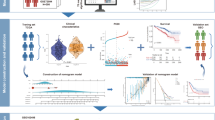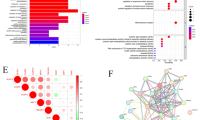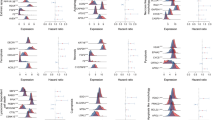Abstract
Background
Lung adenocarcinoma (LUAD) seriously threatens people’s health worldwide. Programmed cell death (PCD) plays a critical role in regulating LUAD growth and metastasis as well as in therapeutic response. However, currently, there is a lack of integrative analysis of PCD-related signatures of LUAD for accurate prediction of prognosis and therapeutic response.
Methods
The bulk transcriptome and clinical information of LUAD were obtained from TCGA and GEO databases. A total of 1382 genes involved in regulating 13 various PCD patterns (apoptosis, necroptosis, pyroptosis, ferroptosis, cuproptosis, netotic cell death, entotic cell death, lysosome-dependent cell death, parthanatos, autophagy-dependent cell death, oxeiptosis, alkaliptosis and disulfidptosis) were included in the study. Weighted gene co-expression network analysis (WGCNA) and differential expression analysis were performed to identify PCD-associated differential expression genes (DEGs). An unsupervised consensus clustering algorithm was used to explore the potential subtypes of LUAD based on the expression profiles of PCD-associated DEGs. Univariate Cox regression analysis, Least Absolute Shrinkage and Selection Operator (LASSO) regression, Random Forest (RF) analysis and stepwise multivariate Cox analysis were performed to construct a prognostic gene signature. The “oncoPredict” algorithm was utilized for drug-sensitive analysis. GSVA and GSEA were utilized to perform function enrichment analysis. MCPcounter, quanTIseq, Xcell and ssGSEA algorithms were used for tumor immune microenvironment analysis. A nomogram incorporating PCDI and clinicopathological characteristics was established to predict the prognosis of LUAD patients.
Results
Forty PCD-associated DEGs related to LUAD were obtained by WGCNA analysis and differential expression analysis, followed by unsupervised clustering to identify two LUAD molecular subtypes. A programmed cell death index (PCDI) with a five-gene signature was established by machine learning algorithms. LUAD patients were then divided into a high PCDI group and a low PCDI group using the median PCDI as a cutoff. Survival and therapeutic analysis revealed that the high PCDI group had a poor prognosis and was more sensitive to targeted drugs but less sensitive to immunotherapy compared to the low PCDI group. Further enrichment analysis showed that B cell-related pathways were significantly downregulated in the high PCDI group. Accordingly, the decreased tumor immune cell infiltration and the lower tumor tertiary lymphoid structure (TLS) scores were also found in the high PCDI group. Finally, a nomogram with reliable predictive performance PCDI was constructed by incorporating PCDI and clinicopathological characteristics, and a user-friendly online website was established for clinical reference (https://nomogramiv.shinyapps.io/NomogramPCDI/).
Conclusion
We performed the first comprehensive analysis of the clinical relevance of genes regulating 13 PCD patterns in LUAD and identified two LUAD molecular subtypes with distinct PCD-related gene signature which indicated differential prognosis and treatment sensitivity. Our study provided a new index to predict the efficacy of therapeutic interventions and the prognosis of LUAD patients for guiding personalized treatments.








Similar content being viewed by others
Data availability
Publicly available datasets were analyzed in this study. These data can be found here: https://portal.gdc.cancer.gov/ and https://www.ncbi.nlm.nih.gov/geo/.
References
Aran D, Hu Z, Butte AJ (2017) xCell: digitally portraying the tissue cellular heterogeneity landscape. Genome Biol 18(1):220
Badgley MA et al (2020) Cysteine depletion induces pancreatic tumor ferroptosis in mice. Science (new York NY) 368(6486):85–89
Bagchi S, Yuan R, Engleman EG (2021) Immune checkpoint inhibitors for the treatment of cancer: clinical impact and mechanisms of response and resistance. Annu Rev Pathol 16:223–249
Becht E et al (2016) Estimating the population abundance of tissue-infiltrating immune and stromal cell populations using gene expression. Genome Biol 17(1):218
Bergomas F et al (2011) Tertiary intratumor lymphoid tissue in colo-rectal cancer. Cancers (Basel) 4(1):1–10
Bertheloot D, Latz E, Franklin BS (2021) Necroptosis, pyroptosis and apoptosis: an intricate game of cell death. Cell Mol Immunol 18(5):1106–1121
Butera G et al (2019) Regulation of autophagy by nuclear GAPDH and its aggregates in cancer and neurodegenerative disorders. Int J Mol Sci 20(9):2062
Cabrita R et al (2020) Tertiary lymphoid structures improve immunotherapy and survival in melanoma. Nature 577(7791):561–565
Chandrashekar DS et al (2022) UALCAN: an update to the integrated cancer data analysis platform. Neoplasia (new York, N.y.) 25:18–27
Cottrell TR et al (2018) Pathologic features of response to neoadjuvant anti-PD-1 in resected non-small-cell lung carcinoma: a proposal for quantitative immune-related pathologic response criteria (irPRC). Ann Oncol 29(8):1853–1860
de Chaisemartin L et al (2011) Characterization of chemokines and adhesion molecules associated with T cell presence in tertiary lymphoid structures in human lung cancer. Cancer Res 71(20):6391–6399
Denisenko TV, Budkevich IN, Zhivotovsky B (2018) Cell death-based treatment of lung adenocarcinoma. Cell Death Dis 9(2):117
Dieu-Nosjean MC et al (2008) Long-term survival for patients with non-small-cell lung cancer with intratumoral lymphoid structures. J Clin Oncol 26(27):4410–4417
Dixon SJ et al (2012) Ferroptosis: an iron-dependent form of nonapoptotic cell death. Cell 149(5):1060–1072
Dong Z, Bian L, Wang M, Wang L, Wang Y (2021) Identification of a pyroptosis-related gene signature for prediction of overall survival in lung adenocarcinoma. J Oncol 2021:6365459
Feng X et al (2015) Receptor-interacting protein kinase 3 is a predictor of survival and plays a tumor suppressive role in colorectal cancer. Neoplasma 62(4):592–601
Finotello F et al (2019) Molecular and pharmacological modulators of the tumor immune contexture revealed by deconvolution of RNA-seq data. Genome Med 11(1):34
Friedman J, Hastie T, Tibshirani R (2010) Regularization paths for generalized linear models via coordinate descent. J Stat Softw 33(1):1–22
Fu J et al (2020) Large-scale public data reuse to model immunotherapy response and resistance. Genome Med 12(1):21
Gao W, Wang X, Zhou Y, Wang X, Yu Y (2022) Autophagy, ferroptosis, pyroptosis, and necroptosis in tumor immunotherapy. Signal Transduct Target Ther 7(1):196
Guo JY et al (2011) Activated Ras requires autophagy to maintain oxidative metabolism and tumorigenesis. Genes Dev 25(5):460–470
Hänzelmann S, Castelo R, Guinney J (2013) GSVA: gene set variation analysis for microarray and RNA-seq data. BMC Bioinformatics 14:7
Hinshaw DC, Shevde LA (2019) The tumor microenvironment innately modulates cancer progression. Cancer Res 79(18):4557–4566
Huang HX et al (2020) TFAP2A is a novel regulator that modulates ferroptosis in gallbladder carcinoma cells via the Nrf2 signalling axis. Eur Rev Med Pharmacol Sci 24(9):4745–4755
Langfelder P, Horvath S (2008) WGCNA: an R package for weighted correlation network analysis. BMC Bioinform 9:559
Liu JL et al (2011) Expression of CDK5/p35 in resected patients with non-small cell lung cancer: relation to prognosis. Med Oncol (northwood, London, England) 28(3):673–678
Liu X et al (2023a) Actin cytoskeleton vulnerability to disulfide stress mediates disulfidptosis. Nat Cell Biol 25(3):404–414
Liu CJ et al (2023b) GSCA: an integrated platform for gene set cancer analysis at genomic, pharmacogenomic and immunogenomic levels. Brief Bioinformatics. https://doi.org/10.1093/bib/bbac558
Long JS, Ryan KM (2012) New frontiers in promoting tumour cell death: targeting apoptosis, necroptosis and autophagy. Oncogene 31(49):5045–5060
Love MI, Huber W, Anders S (2014) Moderated estimation of fold change and dispersion for RNA-seq data with DESeq2. Genome Biol 15(12):550
Maeser D, Gruener RF, Huang RS (2021) oncoPredict: an R package for predicting in vivo or cancer patient drug response and biomarkers from cell line screening data. Brief Bioinformatics. https://doi.org/10.1093/bib/bbab260
Mayakonda A, Lin DC, Assenov Y, Plass C, Koeffler HP (2018) Maftools: efficient and comprehensive analysis of somatic variants in cancer. Genome Res 28(11):1747–1756
Peng L et al (2022) Development and validation of a prognostic risk signature for lung adenocarcinoma constructed by six ferroptosis, necroptosis, and pyroptosis-related lncRNAs. J Thorac Dis 14(10):3955–3974
Petitprez F, Meylan M, de Reyniès A, Sautès-Fridman C, Fridman WH (2020) The tumor microenvironment in the response to immune checkpoint blockade therapies. Front Immunol 11:784
Saito M, Suzuki H, Kono K, Takenoshita S, Kohno T (2018) Treatment of lung adenocarcinoma by molecular-targeted therapy and immunotherapy. Surg Today 48(1):1–8
Schumacher TN, Thommen DS (2022) Tertiary lymphoid structures in cancer. Science (new York, N.y.) 375(6576):eabf9419
Singh SS, Dahal A, Shrestha L, Jois SD (2020) Genotype driven therapy for non-small cell lung cancer: resistance, pan inhibitors and immunotherapy. Curr Med Chem 27(32):5274–5316
Sturm G, Finotello F, List M (2020) Immunedeconv: an R package for unified access to computational methods for estimating immune cell fractions from bulk RNA-sequencing data. Methods Mol Biol (clifton, N.J.) 2120:223–232
Su Z, Yang Z, Xu Y, Chen Y, Yu Q (2015) Apoptosis, autophagy, necroptosis, and cancer metastasis. Mol Cancer 14:48
Subramanian A et al (2005) Gene set enrichment analysis: a knowledge-based approach for interpreting genome-wide expression profiles. Proc Natl Acad Sci USA 102(43):15545–15550
Sung H et al (2021) Global Cancer Statistics 2020: GLOBOCAN estimates of incidence and mortality worldwide for 36 cancers in 185 countries. CA Cancer J Clin 71(3):209–249
Tang D, Kang R, Berghe TV, Vandenabeele P, Kroemer G (2019) The molecular machinery of regulated cell death. Cell Res 29(5):347–364
Tang R et al (2020) Ferroptosis, necroptosis, and pyroptosis in anticancer immunity. J Hematol Oncol 13(1):110
Taylor JM (2011) Random survival forests. J Thorac Oncol 6(12):1974–1975
Thommen DS et al (2018) A transcriptionally and functionally distinct PD-1(+) CD8(+) T cell pool with predictive potential in non-small-cell lung cancer treated with PD-1 blockade. Nat Med 24(7):994–1004
Tower J (2015) Programmed cell death in aging. Ageing Res Rev 23(Pt A):90–100
Travis WD (2011) Pathology of lung cancer. Clin Chest Med 32(4):669–692
Tsvetkov P et al (2022) Copper induces cell death by targeting lipoylated TCA cycle proteins. Science (new York, N.y.) 375(6586):1254–1261
Wang Y, Kanneganti TD (2021) From pyroptosis, apoptosis and necroptosis to PANoptosis: a mechanistic compendium of programmed cell death pathways. Comput Struct Biotechnol J 19:4641–4657
Wang Y et al (2017a) Distinct interactions of EBP1 isoforms with FBXW7 elicits different functions in cancer. Cancer Res 77(8):1983–1996
Wang H et al (2017b) Fractalkine/CX3CR1 induces apoptosis resistance and proliferation through the activation of the AKT/NF-κB cascade in pancreatic cancer cells. Cell Biochem Funct 35(6):315–326
Wang G et al (2021) ERO1α mediates endoplasmic reticulum stress-induced apoptosis via microRNA-101/EZH2 axis in colon cancer RKO and HT-29 cells. Hum Cell 34(3):932–944
Wilkerson MD, Hayes DN (2010) ConsensusClusterPlus: a class discovery tool with confidence assessments and item tracking. Bioinformatics (oxford, England) 26(12):1572–1573
Wu G, Feng D, Zhang Z, Zhang G, Zhang W (2022) Establishment of lung adenocarcinoma classification and risk model based on necroptosis-related genes. Front Genet 13:1037011
Xing P et al (2019) Efficacy of crizotinib for advanced ALK-rearranged non-small-cell lung cancer patients with brain metastasis: a multicenter, retrospective study in China. Target Oncol 14(3):325–333
Yoshihara K et al (2013) Inferring tumour purity and stromal and immune cell admixture from expression data. Nat Commun 4:2612
Yu G, Wang LG, Han Y, He QY (2012) clusterProfiler: an R package for comparing biological themes among gene clusters. OMICS 16(5):284–287
Zhang Y, Zhang Z (2020) The history and advances in cancer immunotherapy: understanding the characteristics of tumor-infiltrating immune cells and their therapeutic implications. Cell Mol Immunol 17(8):807–821
Zhang A, Yang J, Ma C, Li F, Luo H (2021) Development and validation of a robust ferroptosis-related prognostic signature in lung adenocarcinoma. Front Cell Dev Biol 9:616271
Zheng T, Liu Q, Xing F, Zeng C, Wang W (2023) Disulfidptosis: a new form of programmed cell death. J Exp Clin Cancer Res 42(1):137
Zhou B et al (2020) Ferroptosis is a type of autophagy-dependent cell death. Semin Cancer Biol 66:89–100
Zhou N et al (2023) FerrDb V2: update of the manually curated database of ferroptosis regulators and ferroptosis-disease associations. Nucleic Acids Res 51(D1):D571-d582
Zou Y et al (2022) Leveraging diverse cell-death patterns to predict the prognosis and drug sensitivity of triple-negative breast cancer patients after surgery. Int J Surg (london, England) 107:106936
Funding
This work was supported by National Natural Science Foundation of China (Nos. 31870781, 81672858).
Author information
Authors and Affiliations
Contributions
PZ, FC and QW designed the study. QW performed the acquisition and analysis of data. FC, XJ, XM and YZ collected clinical samples and performed IHC analysis. QW wrote the manuscript. PZ edited the manuscript. All authors read and approved the final manuscript.
Corresponding authors
Ethics declarations
Conflict of interest
The authors declare that they have no conflicts of interest to disclose.
Additional information
Publisher's Note
Springer Nature remains neutral with regard to jurisdictional claims in published maps and institutional affiliations.
Supplementary Information
Below is the link to the electronic supplementary material.
Rights and permissions
Springer Nature or its licensor (e.g. a society or other partner) holds exclusive rights to this article under a publishing agreement with the author(s) or other rightsholder(s); author self-archiving of the accepted manuscript version of this article is solely governed by the terms of such publishing agreement and applicable law.
About this article
Cite this article
Wei, Q., Jiang, X., Miao, X. et al. Molecular subtypes of lung adenocarcinoma patients for prognosis and therapeutic response prediction with machine learning on 13 programmed cell death patterns. J Cancer Res Clin Oncol 149, 11351–11368 (2023). https://doi.org/10.1007/s00432-023-05000-w
Received:
Accepted:
Published:
Issue Date:
DOI: https://doi.org/10.1007/s00432-023-05000-w




